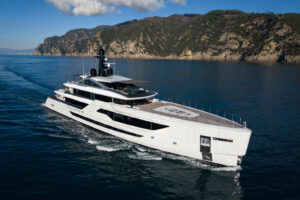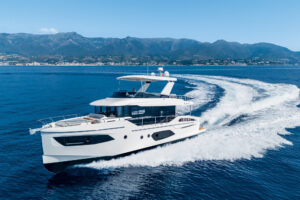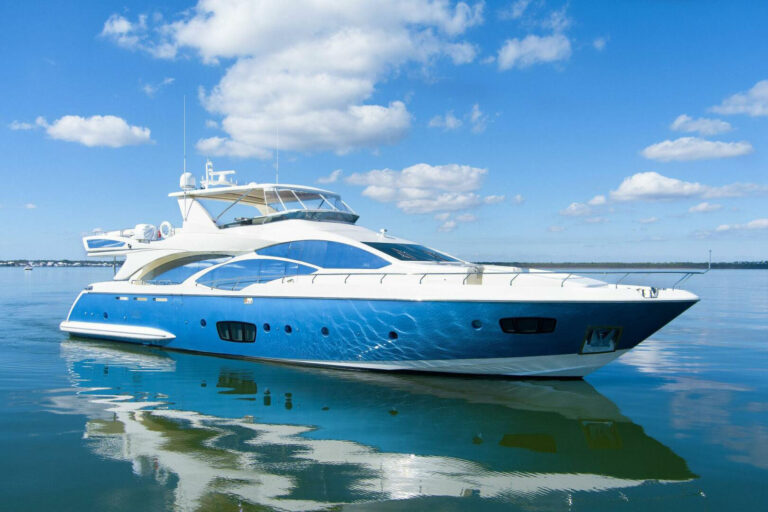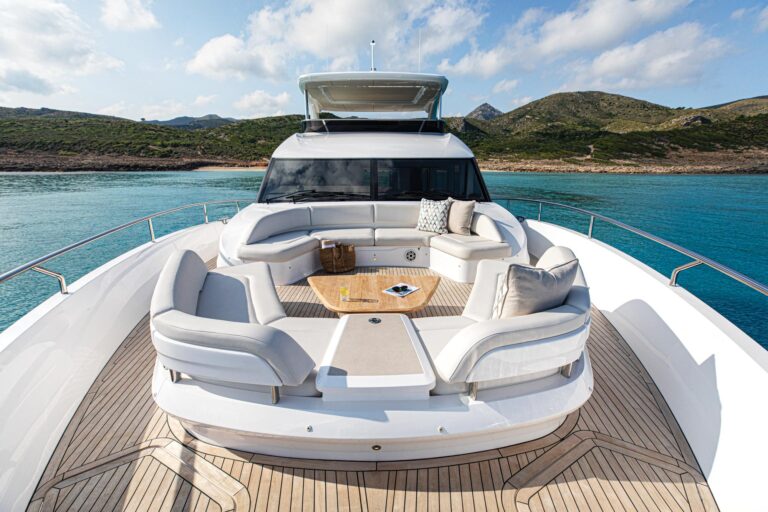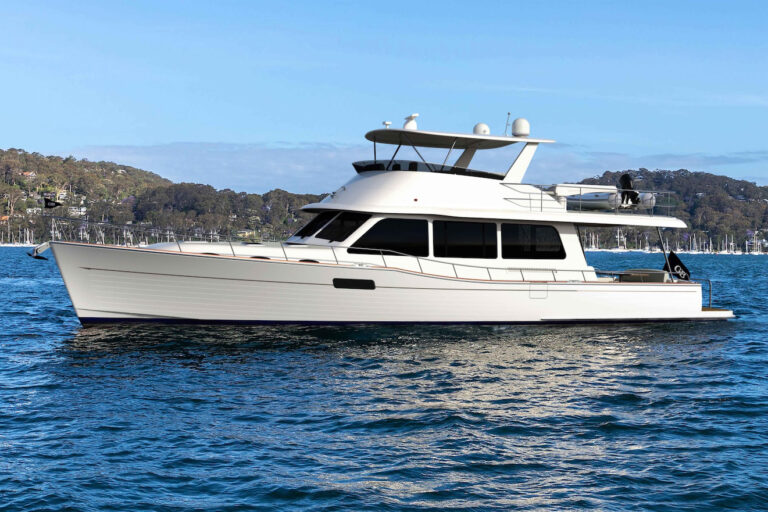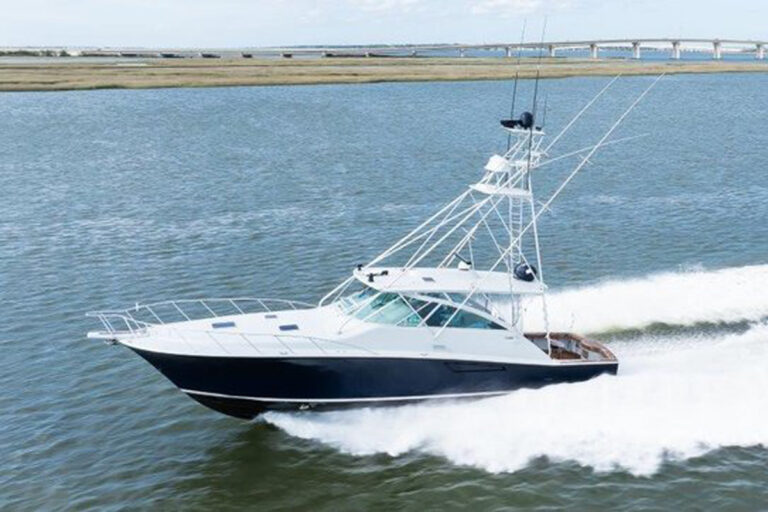_
Zaraffa_ is a 66-foot lightweight speedster that is all business outside and surprisingly livable inside. Her owner is a pragmatic New Englander with a seriously competitive nature and an uncompromising taste for exceptional speed and handling in his cruising yachts. Zaraffa is the product of his vision as interpreted by Reichel/Pugh Yacht Design and rendered by New England Boatworks of Portsmouth, Rhode Island. She’s beautiful in the same way the Le Mans-winning Audi R8 race car is beautiful, but Zaraffa is wonderfully usable for so much more than racing.
If Nathanael Herreshoff were alive today, he would love the ambience belowdecks. She has a simple fully equipped interior, some of which can be removed to lighten the boat for racing. If you like simplicity, you’ll find her accommodations inviting. She doesn’t have a liner, but New England Boatworks faired and painted the back side of the laminate to a satiny off-white. Blond beechwood trims the edges of the counters, companionways and other bits of molded furniture, and the teak/holly sole anchors the décor. Cedar ceilings in the saloon add a touch of warmth. The high-gloss table at the dinette almost seems out of place.
Reichel/Pugh and the owner wisely avoided the temptation to cram accommodations into the boat’s ends. The living and sleeping spaces occupy about the same volume as the accommodations of a 55-foot dedicated cruising yacht. Concentrating the mass over or near the center of buoyancy limits the pitching motion to an acceptable level. Pitching robs the sail plan of its drive, which slows any boat, but is especially pronounced in very lightweight boats, such as Zaraffa.
I like having the galley so close to the center of the boat’s pitching axis because motion there will be minimal, allowing the cook to work fairly comfortably at sea. This tight, U-shape galley ought to be a safe, efficient work space. A watermaker and real refrigeration get their operating juice from a power takeoff at the front of the auxiliary. Both pieces of equipment add to the pleasure of cruising and will keep the racing crew clean and fed.
Opposite the galley and separated from it by the engineroom is a compact, fully found navigation station. It’s a cozy U shape defined at the forward end by the starboard-side settee and at the after end by the navigator’s berth. The work space is divided almost evenly into a counter forward and aft, joined by a narrow counter running along the side of the hull. A fiddled shelf, parallel to this narrow counter just above eye level, is a great place for reference books, though I’d stow them elsewhere when the weather gets nasty. The liferaft and abandon-ship grab bag also stow in the navigator’s area.
Having the owner’s stateroom under the cockpit suits me just fine. It can’t have standing headroom everywhere, but you’ll find it where you need it-in the head and the dressing area right abaft the engineroom. Zaraffa carries a large percentage of her maximum beam well aft, so the after cabin isn’t as claustrophobic as its location suggests. Overhead hatches and a companionway from the after cockpit naturally brighten and ventilate the space. A tiny desk hung onto the engineroom’s after bulkhead holds a laptop PC, which displays navigational data. Two Pullman berths, one above the master and the other over a built-in single opposite the master double, add sleeping space for overnight races. The forward stateroom has two built-in singles, two Pullmans and a private head. All the Pullmans adjust to compensate for the boat’s heeling angle, so the crew can sleep on the level.
You’ll want to invite a few friends if you expect to use all the sail plan’s power, because none of the sail-handling gear benefits from power assist. In this boat’s racing class, power assist isn’t permitted. A pair of Lewmar coffee grinders, one in the after cockpit for the mainsail and one in the forward cockpit for the headsails, provide enough mechanical advantage to quickly trim the sails.
For most of my years at Yachting, I carried weather with me on every boat test and delivery passage. I think it lived in the image of the Tasmanian Devil embroidered on the back of my favorite sailing shirt. When he began playing too rough too frequently, I left him home more often than not. I missed him, though, when I sailed Zaraffa on Narragansett Bay one steamy light-air day in August. Skipper Roger Erker, along with a few of his regular crew and a couple volunteers, had invited me to join in a day of testing and instrumentation calibration.
We sailed under main and 145 genoa in winds of no more than 12 knots true. Beating down the bay toward Newport, Zaraffa showed 7.5 to 8 knots in 11 to 12 knots of true wind speed and 31 degrees of true wind angle. At one point, the apparent wind angle tightened to the impossibly narrow angle of 21 degrees, but Zaraffa didn’t slow. For this stellar windward ability we can thank her 12 feet of draft, the plan form of her keel and the deep, powerful rudder. Her steering was light and delightfully quick (2.25 turns from lock to lock), so corrections required a sensitive touch to prevent oversteering. Tacking was lightning quick and as sure as the sunrise.
By the time we finished tacking down the bay, the wind abandoned us. We broad reached up the bay in an average wind speed of 5 knots, making wind speed or better, depending on how attentive we were to sail trim and steering inputs. A short time before we dropped sail and fired up the Yanmar, Zaraffa gave us 4.75 knots in a true wind speed of 3.5 knots.
Reichel/Pugh has expertly juggled the small waterplane area with a flat run and the broad shoulders the yacht needs for offwind planing, so she’s fast in most wind conditions. Her underbody is a squished semicircle but is flat in way of the keel. Her entry is fine and steep. This combination of characteristics and her light weight promise a lively motion at sea, more or less comfortable depending on the length of the waves.
Zaraffa and her ilk aren’t for every sailor. High-performance boats, like their automotive counterparts, require a high level of commitment and skill, which is exactly the reason some of us fall in love with them. They stretch our abilities. A sophisticated boat of this sort could sell for about $1.2 to $2 million, depending on how high-tech you want the laminate and how you outfit her. Price, though, is irrelevant when you know what you want and where to get it.
Contact: Reichel/Pugh Yacht Design, (619) 223-2299; fax (619) 224-1698; www.reichel-pugh.com. New England Boatworks, (401) 683-6110; fax (401) 683-6988; info@neboatworks.com; www.neboatworks.com.
To view a gallery of the Reichel/Pugh 115 Classic Racer, click here.
To see photos of Reichel/Pugh My Song sailing off the coast of Sardinia, click here.

